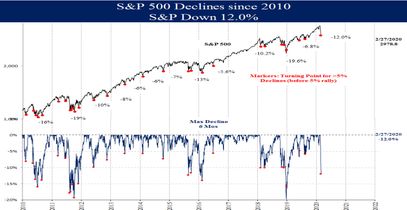Current Implications for Asset Classes
In lieu of our regular monthly research piece, we are continuing to provide you with more regular
briefings on our analysis of markets and the environment as they evolve.
Current Implications for Asset Classes
Through Wednesday, the stock market decline was looking to us like a normal bull market correction. Conditions included a loose Fed combined with bullish extremes in volatility and sentiment. These conditions indicated a low point in the stock market was near, despite the coronavirus. Economic outlook signals showed the economy might slow–conditions consistent with prior stock market declines in this cycle, like 2011, 2016, and 2018.
We reached a tipping point on Wednesday night with the Presidential address to announce closing of U.S. borders to Europe. While some fear is historically bullish for stocks, it has now reached a point that a liquidity crisis and a recession are real risks. Therefore, we have reduced our ratings on all stocks from a bullish 5 to an average equity 3 rating, until there is further economic clarity on these risks.
Current Conditions
Liquidity Risk: Credit spreads are a good indication of a properly functioning bond market and measure the ability for companies to fund operations. As volatility persists, the risk of credit drying up increases. Bloomberg News reported this week that companies are calling in their bank lines of credit, as if the funds may not be available in the months ahead. High yield spreads broke above 6% last week, indicating investors were selling debt of leveraged companies (normal spreads are around 3%) . This is our best indicator for the risk of a liquidity crisis. A liquidity crisis combined with a sharply slowing economy risks a snowball effect with debt defaults and an economic recession. In the table below you can see bear markets combined with recessions are more severe.


The Federal Reserve: The Fed has indicated they would do whatever it takes to provide liquidity to the market and economy.
- 3/2/20: Emergency interest rate cut by 0.50%
- 3/12/20: $1.5 trillion of temporary liquidity of overnight repurchase operations (repo’s) and expand buying $60 billion a month in Treasury bills to other maturities
How much lower can the S&P 500 go?
The market volatility is extreme by any measure. For perspective, the S&P 500 has moved an average of 4% a day for the last two weeks, 13 times the norm of 0.3%. It’s the highest since 2008, and before that 1987, a once in 11-year event.

In addition, the S&P 500 is down 25% within the last month, one of the biggest one-month declines on record. However, larger one month declines occurred in 2008 (-30%), 1987 (-33%), and 1929 (43%).


Relief Rallies
In studying prior stock market declines like 1962, 1987, and 2008, there is a reliable pattern of snap back 10-15% rallies over just 2-3 days. When this happened in those prior cases, the market then declined back to the low. It is not something we are necessarily responding to by making portfolio changes, but it is important to be aware of the pattern. The tendency is for investors to buy that first rally, which can be expected to reverse quickly. Today may be the start of one of those rallies.
Gold Rating Cut
We cut our gold rating from a bullish 5 to a neutral 3 based on the 2008 comparison when gold declined 25% from the high as stocks declined and the dollar rallied as it has done so far this year. A loose Fed is bullish for gold if the dollar declines, but in this sort of stock market volatility, the dollar has rallied in a flight to safety, and this has become a risk for gold.

Going forward, we will continue to closely monitor for additional signs of a possible liquidity crisis. These signs would include companies defaulting on debt or going bankrupt, continued volatility in stocks, and economic news which confirms expected weakening.
IMPORTANT DISCLOSURES
This review and outlook report (this “Report”) is for informational, illustration and discussion purposes only and is not intended to be, nor should it be construed as, financial, legal, tax or investment advice, of Brenton Point Wealth Advisors LLC or any of its affiliates (“Brenton Point”). This Report does not take into account the investment objectives, financial situation, restrictions, particular needs or financial, legal or tax situation of any particular person and should not be viewed as addressing any recipient’s particular investment needs. Recipients should consider the information contained in this Report as only a single factor in making an investment decision and should not rely solely on investment recommendations contained herein, if any, as a substitution for the exercise of independent judgment of the merits and risks of investments.
This material is based upon information obtained from various sources that Brenton Point believes to be reliable, but Brenton Point makes no representation or warranty with respect to the accuracy or completeness of such information. Views expressed herein are current only as of the date indicated and are subject to change without notice.
This Report contains certain forward looking statements opinions, estimates, projections, assessments and other views (collectively “Statements”). These Statements are subject to a number of assumptions, risks and uncertainties which may cause actual results, performance or achievements to be materially different from future results, performance or achievements expressed or implied by these forward looking statements and projections. Brenton Point makes no representations as to the reasonableness of such assumptions or the likelihood that such assumptions will coincide with actual events and this information should not be relied upon for that purpose. Changes in such assumptions could produce materially different results. Past performance is not a guarantee or indication of future results, and no representation or warranty, express or implied, is made regarding future performance of any financial instrument mentioned in this Report.
Any benchmark shown herein is shown for illustrative purposes only. No index benchmark is available for direct investment. It may not be possible to replicate the returns of any index, as the index may not include any trading commissions and costs or fees, may assume the reinvestment of income, and may have investment objectives, use trading strategies, or have other materials characteristics, such as credit exposure or volatility, that do not make it suitable for a particular person. This is not an offer or solicitation for the purchase or sale of any security, investment, or other product and should not be construed as such. References to specific financial instruments and to certain indices are for illustrative purposes only and provided for the purpose of making general market data available as a point of reference only; they are not intended to be, and should not be interpreted as recommendations to purchase or sell such securities. Investing in securities and other financial products entails certain risks, including the possible loss of the entire principal amount invested, as the value of investment can go down as well as up. You should obtain advice from your tax, financial, legal, and other advisors and only make investment decisions on the basis of your own objectives, experience, and resources.
Brenton Point accepts no liability for any loss (whether direct, indirect or consequential) occasioned to any person acting or refraining from action as a result of any material contained in or derived from this Report, except to the extent (but only to the extent) that such liability may not be waived, modified or limited under applicable law.
This Report may provide addresses of, or contain hyperlinks to, Internet websites. Brenton Point has not reviewed the linked Internet website of any third party and takes no responsibility for the contents thereof. Each such address or hyperlink is provided solely for your convenience and information, and the content of linked third party websites is not in any way incorporated herein. Recipients who choose to access such third-party websites or follow such hyperlinks do so at their own risk.
All marks referenced herein are the property of their respective owners. This Report is licensed for non-commercial use only, and may not be reproduced, distributed, forwarded, posted, published, transmitted, uploaded or otherwise made available to others for commercial purposes, including to individuals within an institution, without written authorization from Brenton Point.
Source of data and performance statistics: Bloomberg L.P. and Factset Research Systems Inc.
©Brenton Point Wealth Advisors LLC 2020

Michael Schaus
Director of Market Research
Michael Schaus is the Director of Market Research for Brenton Point Wealth Advisors and Zweig-DiMenna. Since joining Zweig-DiMenna in 1992, his focus has been on macroeconomic research, the analysis of…
READ MORERead Next:
Sign up!
Sign up for our monthly newsletter and get the lastest news and research from our esteemed advisors here at Brenton point. Right into your inbox!


 Client Login
Client Login


